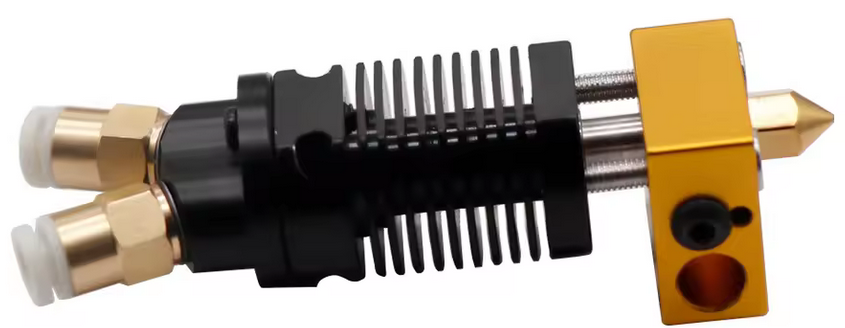::: spoiler some info Generally, clogs are the primary issue that prevents multi material in any such automatic filament changing system.
The secondary issue is that even when restricting the system to multi color, every color will have issues with dialing in the amount of purge needed to clear the chamber of the melt zone. If you can develop a mental picture if the melt zone, the tube between the heatsink and the heat block is ~1.8mm diameter, and so is the nozzle. The nozzle has a tip orifice that is 0.1mm-1mm diameter. The taper between the tube and the tip orifice is just whatever angle drill bit was used in the CNC lathe operation. Inside it is just a hollow simple cone shape. There are two potential places in the melt zone where residual filament can be trapped. There is the angular transition between the hollow cylinder to the hollow cone inside the nozzle. Then there is the groove from a relief chamfer added to both surfaces where the nozzle tightens to the tube.
Thirdly, all PID temperature control algorithms require time to stabilize. When you make changes to the melt zone there will be considerable over and undershoot that follow.
Fourthly, you never know how much of the melt is going to pull out when each full retraction is made. So you need to purge a lot to ensure you can account for the melt zone.
All of this creates inconsistencies that are more problematic than they are worth for most people by my observations. I haven't tried them myself. I've done a lot of research into IDEX because my inner amateur engineer sends up major red flags when I think about multi filament setups.
Just to get ahead of it, with IDEX the issue is that cheap 3D printers are not at all accurate, they are very precise. Precision is the only thing that matters when you are printing with the one print head. In other words (0, 0) on your print bed is never an absolute location it varies. It seems like it is the same, but in terms of true accuracy, it is not. You never experience this unless you try to restart a print manually. The issue is hard to solve and requires much more expensive closed loop linear actuator systems to solve well. Even with this, the major challenge is calibrating the nozzle height of both print heads and their squish properties.
You might notice that with multicolor prints, most of the examples you see are either the occasional manual swap someone like myself does, or people with a business or print farm that are motivated to dial in exactly what is needed for a specific combination of filaments with a single print. I try not to pay attention to anything pros like this print in examples. When I start seeing average functional prints that include multi materials in more casual designs, then I start considering the tech viable in practice. From what I have seen, most hobby 3d prints using multi materials are not of the practical variety. I would be making parts that incorporate TPU/TPE grips and hinges into my designs. I could print something like an audio driver that incorporates the cone and spider in one print. I need to see stuff like this, from people with no vested interest, that are not just showing off what is possible or shilling some printer. I don't take them seriously otherwise. As far as I'm concerned, all multi color setups are only for print farms, and multi material is not at all relevant to me and my use case. IDEX is the engineered solution, but I'm not at a true hardware developer skill level and open source doesn't have very good support for slicing and calibrating IDEX. Eddie the Engineer was messing with this on the Voron team with a Trident for awhile, but I lost track and am not up to date on the project.
